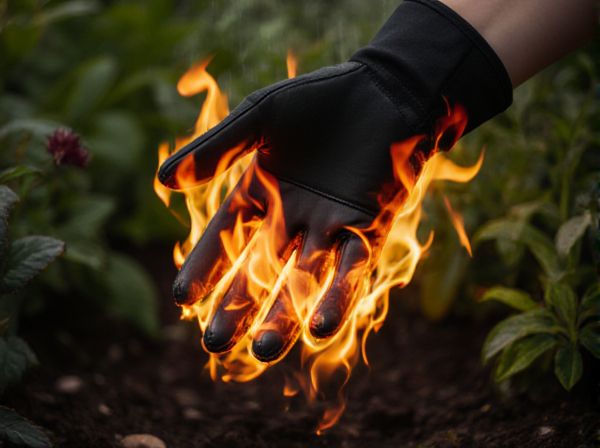
Fire blight vs Bacterial blight Illustration
Fire blight and bacterial blight are both destructive plant diseases caused by bacterial pathogens but differ in their host range and symptoms. Fire blight typically affects members of the Rosaceae family, such as apple and pear trees, causing blackened, wilted shoots that appear scorched by fire. Bacterial blight affects a wider variety of plants, including beans and rice, leading to water-soaked lesions, leaf spots, and defoliation that reduce crop yield and quality.
Table of Comparison
| Disease | Pathogen | Host Plants | Symptoms | Transmission | Control Methods |
|---|---|---|---|---|---|
| Fire Blight | Erwinia amylovora | Apple, pear, quince | Blackened shoots, cankers, ooze | Insect vectors, rain splash | Pruning, copper sprays, resistant varieties |
| Bacterial Blight | Xanthomonas spp. | Beans, rice, walnut | Leaf spots, water-soaked lesions, wilting | Seed, rain splash, tools | Seed treatment, crop rotation, bactericides |
Understanding Fire Blight and Bacterial Blight
Fire blight, caused by the bacterium Erwinia amylovora, primarily affects apple and pear trees, resulting in blackened shoots and oozing lesions, while bacterial blight, often caused by Xanthomonas species, targets crops like beans and rice, leading to leaf spots and wilting. Both diseases are bacterial in nature but differ in host range, symptoms, and environmental conditions favoring their spread. Effective management relies on early detection, proper sanitation, and selecting resistant cultivars tailored to each specific pathogen.
Key Differences Between Fire Blight and Bacterial Blight
Fire blight, caused by the bacterium Erwinia amylovora, primarily affects apple and pear trees, leading to blackened, wilted shoots and a characteristic shepherd's crook appearance. Bacterial blight, often caused by Xanthomonas species, targets a broader range of crops including beans, rice, and cotton, producing water-soaked lesions and leaf spots. The key difference lies in host specificity and symptom development, with fire blight causing rapid tissue necrosis and bacterial blight resulting in more localized leaf damage.
Common Symptoms of Fire Blight
Fire blight commonly presents with blackened, wilted blossoms and shoots that appear scorched, often curling into a characteristic shepherd's crook shape. Oozing amber bacterial exudate may be visible on infected branches during warm, humid conditions. The disease primarily affects apple and pear trees, causing rapid dieback and cankers that girdle branches and trunks.
Common Symptoms of Bacterial Blight
Bacterial blight commonly manifests as water-soaked lesions on leaves, which rapidly enlarge and turn dark brown to black, often leading to leaf wilting and drop. Infected shoots exhibit blackened, shriveled tips known as "shepherd's crook," while cankers form on branches causing dieback. These symptoms facilitate bacterial ooze under humid conditions, promoting disease spread in crops like beans, rice, and cotton.
Plant Hosts Susceptible to Fire Blight
Apple, pear, and hawthorn are the primary plant hosts susceptible to fire blight, caused by the bacterium Erwinia amylovora. This disease predominantly affects members of the Rosaceae family, leading to wilting, blackening, and dieback of shoots and branches. Unlike bacterial blight, which affects various crops like rice and beans, fire blight specifically targets woody plants in temperate regions, making orchard management crucial for prevention.
Plant Hosts Susceptible to Bacterial Blight
Bacterial blight primarily affects plant hosts such as beans, rice, soybeans, and cotton, causing water-soaked lesions and leaf blight. Unlike fire blight, which targets members of the Rosaceae family like apple and pear trees, bacterial blight has a broader host range among important agricultural crops. Effective disease management relies on understanding host susceptibility and implementing resistant varieties and proper cultural practices.
Causes and Transmission of Fire Blight
Fire blight is caused by the bacterium Erwinia amylovora, which primarily affects apple, pear, and crabapple trees. The pathogen spreads through rain, wind, insects such as bees, and contaminated pruning tools, infecting susceptible plant tissues like blossoms, shoots, and branches. In contrast, bacterial blight involves different bacterial species and transmission modes, often affecting crops like beans and rice rather than fruit trees.
Causes and Transmission of Bacterial Blight
Bacterial blight is primarily caused by the pathogen Xanthomonas campestris pv. campestris, which infects plants through natural openings or wounds. Transmission occurs via contaminated seeds, water splash, insects, and farming tools that spread the bacteria from infected to healthy plants. Environmental conditions such as high humidity and warm temperatures facilitate rapid bacterial multiplication and disease spread.
Effective Prevention Strategies for Both Diseases
Effective prevention strategies for fire blight and bacterial blight emphasize the use of disease-resistant plant varieties and proper sanitation practices. Implementing regular pruning to remove infected branches and applying appropriate bactericides during vulnerable periods significantly reduce the spread of these bacterial diseases. Maintaining optimal plant health through balanced fertilization and avoiding overhead irrigation further minimizes infection risks.
Treatment and Management of Fire Blight vs Bacterial Blight
Effective treatment and management of fire blight involve pruning infected branches promptly and applying streptomycin or copper-based bactericides during bloom periods on susceptible apple and pear trees. Bacterial blight control emphasizes the use of resistant cultivars, rigorous sanitation to remove infected plant debris, and the application of copper sprays primarily on walnut and bean crops. Both diseases require monitoring environmental conditions, such as warm and moist weather, which favor pathogen spread, to time interventions accurately and reduce infection rates.
Fire blight vs Bacterial blight Infographic

 gardendif.com
gardendif.com